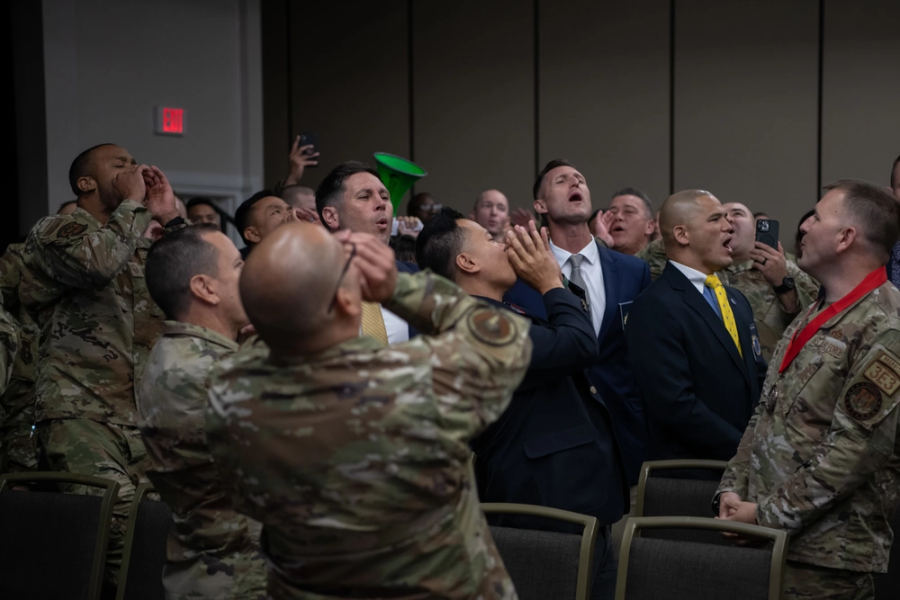After two years of storm clouds, the future looks bright for Air Force Reserve Command recruiting, which exceeded its fiscal year 2024 goal of 7,200 Airmen by about 1.2 percent.
The news marks a sharp comeback from fiscal 2022, where the Reserve fell short about 1,500 recruits, and fiscal 2023, which saw a nearly 30 percent shortfall in both the Reserve and the Air National Guard.
Even this April, the forecast looked bleak, with AFRC commander Lt. Gen. John P. Healy warning Congress the component would miss its end strength goal of 69,600 members by about 2,900.
While AFRC is still short of its end strength, the command succeeded on the recruiting side of things in 2024. Hiring more recruiters did the trick, Healy said.
Air Force Reserve recruiters are Active Guard Reserve (AGR) status, meaning they serve full-time. The trouble was that the number of AGR authorizations was being held at 6,000 since 2022, “so we couldn’t increase our AGR end strength anywhere in the Air Force Reserve,” Healy told reporters at AFA’s Air, Space & Cyber Conference.
During fiscal 2019, the Air Force Reserve had 298 Reserve recruiters looking to bring in both new Airmen off the street and prior Active service members looking for a change. But then the COVID-19 pandemic hit, recruiter retention rates sank, and the number of recruiters fell to below 220 by the end of fiscal 2022.
Over the past two years, Healy bumped the level of recruiters up to 237, “and we’ve seen the results of that already this year,” he said.
Incentives also help. In 2023, the command rolled out a $10,000 bonus for fully-qualified, prior-service enlisted Airmen who signed up for three-year commitments in the Reserve. Today the Air Force recruiting website advertises up to $15,000 bonuses for many enlisted specialties.
“At the end of the day, we want our Active-Duty Airmen to serve 20 years in Active-Duty. We’re not trying to poach them,” said AFRC’s senior enlisted leader, Chief Master Sgt. Israel Nuñez. “We’re trying to get the ones who are leaving, see if we can affiliate those individuals.”
Ideally, AFRC aims for 70 percent of its force to be prior-service and 30 percent non-prior service, which helps retain expertise and cut down on training costs, Nuñez explained.
Further progress could be in store as AFRC aims to build the number of recruiters back to 280 over the next few years. That’s still short of 100 percent manning, but it should help the component keep pace with its rising recruiting goals and help it get to full end strength, Healy explained.
“We should expect to see a lift in our AGR end strength, and with that, we should be able to prioritize even greater to the recruiters, so we can get more bodies out there shaking hands and getting people to sign the dotted line,” he said.
Retention at AFRC is “fantastic” at 88.2 percent, the general said, which means recruiting is the last step to hitting end strength goals. He said that the command is working with Lt. Gen. Adrian Spain, the Air Force’s Deputy Chief of Staff for Operations, to come up with new incentives so that more Active Airmen make the jump to the Reserves instead of leaving the service.
Part of that means shoring up quality of life issues such as finding child care during drill weekends amid a nationwide child care provider shortage.
“If it’s already challenging during the week, just imagine how challenging it is during the weekend,” said Nuñez, who flagged affordable, accessible health care as another area he wants to improve for Reservists.
“A data point that we like to provide is that we have close to 800 Reserve members who are currently in a non-deployable status because of a dental issue,” he said. “Had they had good, affordable, quality dental care, they would no longer be on a non-deployable status.”
In the meantime, AFRC has a new goal to hit: 7,600 recruits in fiscal year 2025, or 400 more than this year’s target. The Active-Duty side is seeing a similar bump to 32,500 recruits after hitting this year’s goal of 27,100 Active-duty enlisted Airmen.
Like on the Reserve side, the head of the Air Force Recruiting Service thinks that hiring more recruiters is the key to hitting that goal: AFRS aims to plus-up by 370 recruiting staff this year.
“It’s ambitious, but I believe it is executable,” Brig. Gen. Christopher Amrhein said at the conference. The extra staff “is a sizable jump, and I think it definitely sets us in the best footing we can.”


